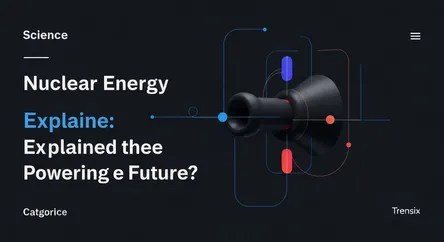Science
Nuclear Energy Explained: Powering the Future?

An overview of nuclear energy, why it's a trending topic in the fight against climate change, and its potential impacts on society.
What is it?
Nuclear energy is the energy stored in the nucleus (core) of an atom. This energy can be released through two main processes: nuclear fission, where the nucleus of an atom is split into two smaller parts, or nuclear fusion, where two light nuclei combine to form a single, heavier nucleus. All commercial nuclear power plants currently in operation use nuclear fission to generate heat. This heat is used to create steam, which then spins turbines to produce electricity. The most common fuel for nuclear fission is uranium, specifically the U-235 isotope, because its atoms are easily split.
Why is it trending?
Nuclear energy is experiencing a resurgence in interest due to the urgent need for carbon-free power to combat climate change. Unlike fossil fuels, nuclear power plants do not produce greenhouse gas emissions during operation. This makes it a crucial tool for countries aiming to achieve net-zero emissions. Furthermore, global electricity demand is surging, partly driven by new technologies like artificial intelligence and data centers. Governments and major tech companies are increasingly looking to nuclear power as a reliable, high-output energy source that can meet this growing demand around the clock, complementing intermittent renewable sources like solar and wind.
How does it affect people?
Nuclear energy offers significant societal benefits, including the production of large amounts of low-carbon electricity and the creation of high-paying jobs. It enhances energy security by reducing dependence on fossil fuels. However, it also poses considerable challenges. The primary concern is the management of radioactive waste, such as spent nuclear fuel, which remains hazardous for thousands of years. Although rare, the risk of accidents like those at Chernobyl and Fukushima raises public safety concerns about the potential for widespread radioactive contamination. The high upfront cost and long construction times for new nuclear plants are also significant economic hurdles.